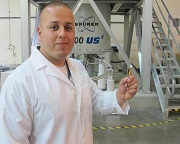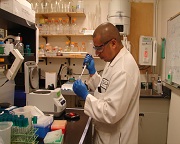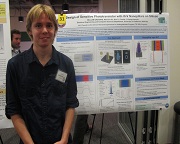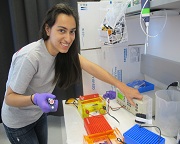Community College Participants and Projects: 2013

Undergraduate Researcher: Sergio Banuelos, Jr
Intended Major: Chemical Engineering
Home Institution: Yuba Community College
Research Project: Analyzing Tobacco Metabolism by NMR for Biofuel Production
Faculty Advisor: Prof. David E. Wemmer
Postdoc Mentor: Dr. J. Pelton
UC Berkeley Department: Department of Chemistry
Project Abstract: Our ultimate end goal is to take sunlight and CO2 and produce biofuels by means of the tobacco plant’s metabolism. My part in this goal is to give the biggest window into the metabolism of the plant by means of Carbon-13 labeling and NMR analysis. This is needed so that geneticists within The Jannson Group (LBNL) can modify plants and monitor the effects of those genetic changes. The way we accomplished this was to extract as many of the metabolites as we could using a 1:1 Methanol Water extraction method, then analyze and identify those metabolites by NMR. We also completed experiments to determine the time window of the production of metabolites in the Calvin and citric acid cycles by introducing only carbon-13 into the plant through the use of labeled 13CO2. This allowed us to see metabolites build up over time by means of the carbon-13 NMR HSQC and compare the spectra according to how long the labeled carbon 13 was allowed to build up. In the end we were able to give the geneticists a better view into the tobacco metabolism so that we can make tobacco a viable biofuel producer through the means of genetic manipulation. Project poster

Undergraduate Researcher: Valentino Calderon
Intended Major: Computer Science
Home Institution: Berkeley City College
Research Project: Developing and Implementing a Privacy Protection Protocol for Mobile Devices
Host: Adam Miller
Research Mentor: N. Good
Hosting Organization: California Department of Justice, Oakland
Project Abstract: Governmental regulation of an industry is needed to mitigate fraud and manipulation within a business. In the mobile device industry, data collection, or collecting personal information on a user, plays a major role in the online economy. Given the potential privacy issues of data collection, the California Department of Justice has been placing mobile app developers under scrutiny. In order to enforce federal and state privacy policies, a man-in-the-middle proxy is used to intercept and record the data collected from mobile app developers. Project poster

Undergraduate Researcher: Alan Cea
Intended Major: Mechanical Engineering
Home Institution: Cosumnes River College
Research Project: Nanophotonics and Negative Index Materials
Faculty Advisor: Prof. Xiang Zhang
Postdoc Mentor: Dr. B. Kante
UC Berkeley Department: Mechanical Engineering
Project Abstract: Recent advancements in nanophotonics reveal new types of materials with negative refractive indexes. By altering the permittivity and permeability of a material, we can engineer new materials called metamaterials, into obtaining a negative refractive index. This project describes the operation and construction of a particular Negative Index Material (NIM) involving the use of Split Ring Resonators (SRR) and a wire frame. These designs will open the gateway to discovering new NIMs with disorderly systems, classifying them as isotropic materials. Project poster

Undergraduate Researcher: Juntai Chen
Intended Major: Mechanical Engineering
Home Institution: City College of San Francisco
Research Project: Intercalation of Cu into N-Type Polycrystalline Bi2Se3
Faculty Advisor: Prof. Junqiao Wu
Postdoc Mentor: Dr. Deyi Fu
UC Berkeley Department: Materials Science & Engineering
Project Abstract: The intercalation of copper into bismuth selenide (Bi2Se3) was investigated using aqueous electrochemical methods together with post-annealing. Carrier concentration ranged from the order of 1018 to 1020 cm-3 were obtained. Fourier Transform Infrared (FTIR) Spectroscopy measurements showed that the optical absorption edge of Bi2Se3 changed with the doping level, which was attributed to possible Burstein-Moss effect. Project poster

Undergraduate Researcher: Ilyssa Evans
Intended Major: Chemical Engineering
Home Institution: San Joaquin Delta College
Research Project: Optomizing Gene Expression by Characterizing Terminators in Saccharomyces Cerevisiae
Faculty Advisor: Prof. John Dueber
Graduate Student Mentors: L. Latimer & Angel Asante
UC Berkeley Department: Department of Bioengineering
Project Abstract: Most laboratories use a limited number of terminators when cloning plasmids. Altering the terminators has not been extensively explored in the fields of metabolic engineering or synthetic biology; however this poses a problem when engineering complex metabolic pathways and an opportunity to further tailor expression. We cloned 16 terminators from the genome of Saccharomyces cerevisiae (baker’s yeast) and characterized their impact on expression by measuring the fluorescence of YFP driven by TDH3 and other promoters. The fluorescence of YFP varied by 190 fold between the weakest and strongest terminators. Additionally, promoters and terminators appear to mostly impact protein expression independently when six terminators were further tested with three other promoters.
– Click Project poster

Undergraduate Researcher: Joseph Falcao
Intended Major: Mechanical Engineering
Home Institution: San Joaquin Delta College
Research Project: Light Induced Moving Molecule
Faculty Advisor: Prof. Michael Crommie
Graduate Student Mentor: G. N. Duc
UC Berkeley Department: Department of Physics
Project Abstract: As technology grows due to the innovation of making devices smaller, the demand for utilizing even smaller objects in the nano-world increases as well. For this reason it is necessary to examine molecules that possess optical mechanical properties in hopes that they will be the new building blocks of the future. Research has shown that the Monorotamer molecule can produce unidirectional rotational movement when powered by UV light. We are interested in using this knowledge to create light induced moving molecule that could later be applied in nano-scaled machines. We tested this property of Monorotamer by placing molecular samples on a metal surface studied by Scanning Tunneling Microscope and applying UV light in durations of 1 hour and 2 hours. STM images were taken before and after UV light was applied to verify the displacement of the Monorotamer molecules.This procedure was repeated numerous times in order to get accurate comparisons between the before and after pictures that were obtained. Project poster

Undergraduate Researcher: Paul Felix
Intended Major: Biochemistry
Home Institution: Rio Hondo College
Research Project: Optimizing Plant-microbe Interactions for Sustainable Supply of Nitrogen for Bioenergy Crops
Research Advisor: Dr. Romy Chakraborty
Mentors: J. Huang & Dr. M. Schicklberger
Hosting Institution: Earth Sciences Division, Lawrence Berkeley National Laboratory
Project Abstract: Nitrogen (N) is an essential component of DNA and proteins. It is also a key element of life that is often limited in plants, which negatively affects their growth. In natural ecosystems, plants are strongly affected by their associated micro-biome. Plants have developed strong, symbiotic relationships with microbes to cope with the low availability of nitrogen in the soil. Optimizing the relationship between plants and diazotrophic bacteria (nitrogen-fixing bacteria) could provide adequate amounts of nitrogen to the host-plant and thus eliminate the need of fertilizer use in energy crop cultivation. TProject posterfore, we investigated the diversity of microbes in Tobacco (Nicotiana tabacum), considered as potential energy crop for bioenergy production. Several bacterial isolates from the phylogenic order Rhizobiales were obtained from the rhizoplane and roots of this plant using several different N-deficient media. Majority of these isolates grew best with simple sugars and small organic acids. Further, we were able to identify isolates capable of fixing molecular nitrogen, as observed from PCR amplification targeting the nifH gene. Together these results help to understand the impact of plant associated microbes on the growth and survival of these biofuel plants. This understanding is necessary for the develop eco-friendly economically sustainable energy crops by decreasing their dependency on fertilizer. Project poster

Undergraduate Researcher: Thomas Freeman
Intended Major: Computer Engineering
Home Institution: Diablo Valley College
Research Project: Energy Disaggregation
Faculty Advisor: Prof. S. Shankar Sastry
Graduate Student Mentor:R. Dong
UC Berkeley Department: Electrical Engineering & Computer Sciences Department
Project Abstract: Energy disaggregation, if solved, may be one of the most important contributions to energy conservation. Energy disaggregation will allow for greater control and optimization of our current energy grid, as well as naturally curb individual energy consumption. Energy disaggregation is the task of breaking up the whole energy signal of a home or business into its individual components. The method used translates a device’s energy consumption pattern into a Hidden Markov Model. After the device models are created, they are joined together to create an Additive Factorial Hidden Markov Model. Then, inference over a household’s energy consumption signal using the Viterbi Algorithm was performed. This in turn gives me the most likely devices consuming energy at any given time period providing the power usage. The method works over small datasets with a low number of devices. However, the approach proves too slow to be considered a complete solution. Project poster

Undergraduate Researcher: William Grenard
Intended Major: Physics & Mathematics
Home Institution: Shasta College
Research Project: Design of Sensitive Phototransistor with III-V Nanopillars on Silicon
Faculty Advisor: Prof. Constance Chang-Hasnain
Graduate Student Mentors: Linda Li & Wilson Ko
UC Berkeley Department: Electrical Engineering & Computer Sciences Department
Project Abstract: The need for amplifiers in optoelectronic receivers makes these devices highly inefficient. In order to eliminate the need for these amplifiers, a photodetector with internal gain is desired. The use of a III-V bipolar junction phototransistor is the proposed design to realize this internal gain. Integration of such a device with silicon is achieved through nanopillar growth of III-V material on silicon. In order to determine device parameters to yield maximum gain, simulations of the nanopillar HPT BJT device were conducted with Sentaurus Device Simulator. Simulations of a pn diode and npn BJT nanopillar device show a high internal electric field at region junctions, predicting a potential for high gain. Project poster

Undergraduate Researcher: David Huang
Intended Major: Electrical Engineering and Computer Science
Home Institution: Cerritos College
Research Project:Device Simulation of Tunnel Field Effect Transistor (TFET)
Faculty Advisor: Prof. Ali Javey
Graduate Student Mentor: Hui Fang
UC Berkeley Department: Electrical Engineering & Computer Sciences Department
Project Abstract: In this project, NanoElectronics MOdeling Tools fifth generation (NEMO5) is used to simulate the TFETs with two different structures, InAs-GaSb and InAs-AlSb-GaSb. AlSb Project poster is acting as an insulator due to its relatively large band gap so that we can easily manipulate the band alignment. The simulation result shows that the sub-threshold swing (S.S) of the first structure (InAs-GaSb) can be reduced to 33 mV/decade, which indicates the performance of TFET can be better than traditional MOSTFETs and demonstrates the potential of TFETs. Furthermore, we investigate how different material properties will affect the performance of TFET. Eventually, we provide an accessible 3D simulation template of TFETs for future study. Project poster

Undergraduate Researcher: Jing Jin
Intended Major: Chemical Engineering & Applied Mathematics
Home Institution: Pasadena City College
Research Project: Fabrication of a Thin Film Transistor (TFT) Based Biosensor for Antioxidants
Faculty Advisor: Prof. Ana Claudia Arias
Postdoc Mentor: Dr. Felippe Pavinatto
UC Berkeley Department: Electrical Engineering & Computer Sciences Department
Project Abstract: Printed biosensors for antioxidants based on the immobilization of the enzyme Tyrosinase are currently being investigated in Ana Aria’s Lab at EECS, UC-Berkeley. Capacitive measurements are being used as detection method, but it is believed that other electrical devices could help to improve biosensors performance. In this project, thin film transistor (TFT) were fabricated using printing techniques and flexible substrates. Inkjet was used to print Au source, drain and gate electrodes in two different transistor architectures, and blade coating or gravure printing was employed to deposit the semiconductor. All layers were characterized regarding their morphology and thickness, and the successful printing was demonstrated. Currently, Tyrosinase is being incorporated to the structures in order for them to be used in biosensing. Project poster

Undergraduate Researcher: Fariba Kianmajd
Intended Major: Biochemistry
Home Institution: American River College
Research Project: Characterization of Tetracycline Inducible Orn Strain UM431
Faculty Advisor: Prof. J. Christopher Anderson
Postdoc Mentor: Dr. Robin Prince
UC Berkeley Department: Department of Bioengineering
Project Abstract: The goal of this project is to characterize and evaluate UM431 which is tetracycline inducible Orn that can be used as a selection tool to identify ligand dependent mutants from a large DNA library with the end goal of generating a synthetic auxotroph E. coli strain. Experimental results demonstrate that the expression of wild-type Orn rescues cell survival while the mutant Orn does not, with 500 fold difference in the survival rate which proves the suitability of the strain for selection. Project poster

Undergraduate Researcher: Manuel Leyva
Intended Major: Mechanical Engineering
Home Institution: Southwestern College
Research Project: Fabrication and Friction Properties of PDMS Pillars with Embedded Particles
Faculty Advisor: Prof. Roya Maboudian
Graduate Student Mentors: Y. Kim
UC Berkeley Department: Department of Chemical & Biomolecular Engineering
Project Abstract: Soft PDMS, a synthetic rubber known for its adhesive properties, has previously been used in an effort to mimic the feet of geckos. However, soft PDMS has mechanical stability issues, like clumping and material strength. By dispersing Iron (III) Oxide into the PDMS sample, the stiffness is increased while the friction force remains unaffected.
– Click Project poster

Undergraduate Researcher: Mitchell Maciorski
Major: Physics
Home Institution: Moorpark College
Research Project: Characterizing the Bilayer TFET
Faculty Advisor: Prof. Eli Yablonovitch
Graduate Student Mentor: Jared Carter
UC Berkeley Department: Electrical Engineering & Computer Sciences Department
Project Abstract: The bilayer tunneling field effect transistor (TFET) is a transistor which utilizes electron tunneling as its switching mechanism. It is currently being investigated as a low power alternative to the conventional MOSFET. Project poster, the electrical properties of an incomplete bilayer TFET are examined by utilizing a MEMS Cascade probe station and two semiconductor parameter analyzers. Through measurement of test devices such as MOS capacitors, Schottky Diodes, and P-N Junctions, device characteristics such as sheet resistance, contact resistivity, oxide current leakage, oxide breakdown voltage, and dopant concentrations were determined. These results display device gate functionality, operating voltage limits, and leakage current density. Project poster

Undergraduate Researcher: Dennis Mulligan
Major: Genetics & Plant Biology
Home Institution: City College of San Francisco
Research Project: Methane Production and the Microbial Community During Thermophillic Composting of Human Waste
Research Host and Mentor: Dr. Yvette Piceno
Hosting Institution: : Ecology Department, Lawrence Berkeley National Laboratory
Project Abstract: In order to evaluate the viability of thermophillic composting as an alternative method for disposing of human waste, we characterized the microbial community using PhyloChip analysis. Project poster, the focus is on Methanogens and Methanotrophs, to gain an understanding of the extent and nature of methane release from these piles during the composting process. In this study, DNA was extracted from three replicate human waste thermophillic compost piles, and the PCR amplified 16S rRNA genes of bacteria and archaea were fragmented, labeled and hybridized to PhyloChips which provides relative abundance values for any species or operational taxonomic unit (OTU) that is present in the GreenGenes database. 10,539 taxa were detected, including 31 methanogens and 79 methanotrophs. Methanogen abundance decreased from the initial values over time, though certain thermophillic species increased. Numbers of OTU detected by PhyloChip decreased over time, more so at the center than the edges of the pile, likely due to increased temperatures at center. Methanotroph abundance varied, decreasing more at the center than edges.
– Click Project poster

Undergraduate Researcher: Nhi Tran
Intended Major: Electrical Engineering & Computer Science
Home Institution: Chabot College
Research Project: Mechanical Switches as Selectors in ReRAM Cells
Faculty Advisor: Prof. Tsu-Jae King Liu
Graduate Student Mentors: C. Qian
UC Berkeley Department: Electrical Engineering & Computer Science Department
Project Abstract: In recent years, ReRAM (Resistive Random Access Memory) has become one of the most promising nonvolatile memories. It is well-known for its high speed and low power consumption. However, ReRAM with high sneak-path leakage current is hindering the efficiency. A mechanical switch (MS) was proposed as a selector in a ReRAM cell to reduce the leakage current. Dimensions and materials of the beam were investigated to achieve the low pull-in and pull-out voltages. Tungsten, which has high melting point, was considered as a good material to be used in mechanical switch structure. In this project, many tests on MS were made to find the best dimension of word line beam (WL) to get both pull-in and pull-out voltages. Project poster
